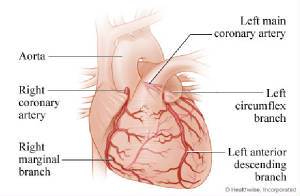|
The heart & the coronary arteries: Front view - Coronary arteries are blood vessels that provide oxygen-rich blood
& other nutrients to the heart muscle. The coronary arteries attach to & wrap around
the heart's surface.
The left coronary artery branches
off into smaller arteries. The most prominent ones are the:
- Left anterior descending artery, which supplies blood to the
front of the heart.
- Left circumflex artery, which encircles the heart muscle, supplying
blood to the back of the heart.

The right marginal branch usually extends from the right coronary artery & supplies blood to the lower right side of the heart.
 
Heart attack
A heart attack (also called myocardial infarction or MI) occurs
when an area of heart muscle is completely deprived of blood, and the heart muscle cells die.
A heart attack may result when plaque inside the heart arteries
breaks open or ruptures, forming a clot that significantly blocks blood flow through the artery.
A plaque is made up of cholesterol, white blood cells, calcium,
and other components; it is surrounded by a fibrous cap. If a sudden surge in blood pressure causes the artery to constrict,
the fibrous cap may tear or rupture. This signals the body to repair the injured artery lining, much as it might heal a cut
on the skin, by forming a blood clot to seal the area. A blood clot that forms in an artery can completely block blood flow
to the heart muscle and cause a heart attack.
The pain of a heart attack often occurs with other symptoms,
including:
- Chest discomfort or pain that is crushing or squeezing or feels
like a heavy weight on the chest.
- Chest discomfort or pain that occurs with:
- Sweating.
- Shortness of breath.
- Nausea or vomiting.
- Pain that spreads from the chest to the neck, the jaw, or one
or both shoulders or arms.
- Dizziness or lightheadedness.
- A fast or irregular heartbeat.
- Loss of consciousness.
The pain of a heart attack usually will not go away with rest.
It is important to recognize the early stages of a heart attack
and to seek emergency care. Medical treatment is needed to prevent death. Sometimes medicines can be given to reduce the damage
to the heart muscle caused by a heart attack.
  Peripheral arterial disease
Peripheral arterial disease
(PAD) is an ongoing condition that results from narrowing of the arteries that supply oxygen-rich blood to the:
- legs
- abdomen
- pelvis
- arms
- neck
The most common cause of this
disease is the buildup of excess cholesterol, calcium & other substances (plaque)
on the inside of arteries, particularly those that feed the legs.
In peripheral
arterial disease, the arteries harden & narrow (atherosclerosis),
reducing blood flow to other parts of the body. As a leg artery narrows, the leg muscles don't get enough blood, especially
during increased activity. When the muscle is in a resting state, the blood supply may be adequate.
The main symptom of peripheral arterial disease in the leg is a tight or squeezing pain in the calf, foot, thigh,
or buttock that occurs during exercise (such as walking up a hill or a flight of stairs,
running, or simply walking a few steps).
This pain is called
intermittent claudication.
It usually happens
after a certain amount of exercise & is relieved by rest. As the condition gets worse, leg pain may occur after only minimal
activity or even when at rest.
Other signs of peripheral arterial disease in the legs include:
- Decreased leg strength & function & poor balance when
standing.
- Cold & numb feet or toes.
- Sores that are slow to heal.
The first goal of treatment for peripheral arterial disease is to identify & change lifestyle factors, such as:
- smoking
- a high-fat diet
- lack of exercise
that may be causing the disease.
Treatment may include cholesterol-lowering
medicine & other medicines to lower the risk of heart attack & stroke. Surgery may be needed if blood flow is significantly decreased to some areas.
  Plaque (artery)
Plaque is a buildup
of cholesterol, white blood cells, calcium & other substances in the walls of arteries. Over time, plaque narrows the
artery & the artery hardens (atherosclerosis).
Plaque sometimes reduces blood
flow to the heart muscle, which can cause chest pain (angina). Plaque in the large artery in the neck (carotid artery stenosis)
may block blood flow to the brain & is a common cause of transient ischemic attacks (sometimes
called "mini-strokes").
Plaques are covered with a
fibrous cap, which may rupture if some trigger causes a surge in blood pressure or causes the artery to constrict. A person
may have a heart attack if a plaque breaks open, creating a blood clot that completely blocks
blood flow thru the artery.
Kerry V. CookeAmy Fackler, MA
 
Stroke
A stroke
is a sudden disruption in blood flow to the brain caused by a blockage or bleeding of a blood vessel. Areas of the brain that
are affected by the blockage or bleeding can become damaged within minutes.
The effects of a stroke may be mild or severe & temporary or permanent, depending on which brain cells are
damaged, how much of the brain is involved & how quickly the blood supply is restored to the area.
Symptoms of a stroke
are usually sudden & may include:
- Numbness, weakness, or lack of movement (paralysis) in the face, an arm, or a leg, especially on only one side of the body.
- Trouble seeing in one or both eyes.
- Confusion & difficulty speaking.
- Dizziness & a loss of balance or coordination.
- Vomiting.
- A sudden, severe headache.
A person with stroke symptoms needs immediate medical attention to help limit potential damage.
|
 |
|

